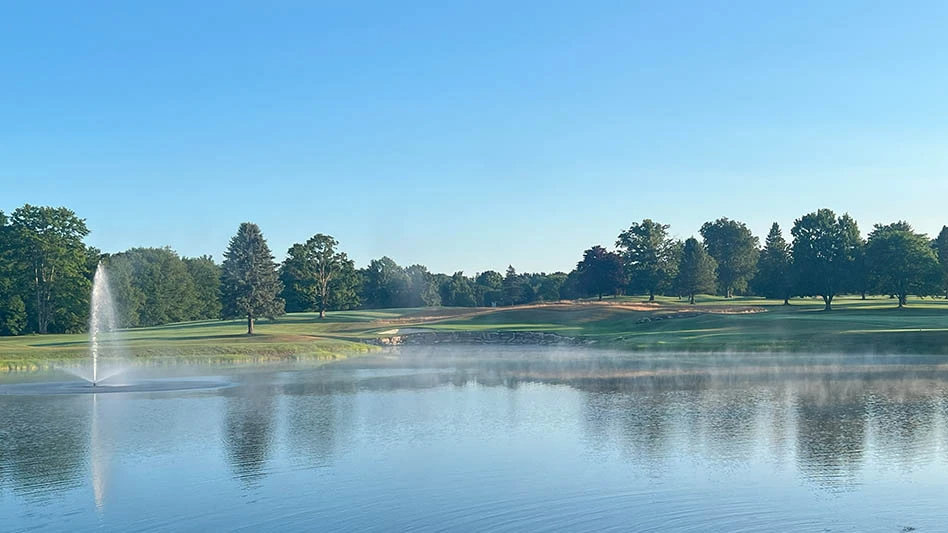

Arthur Stewart owns an energy company in Warren County, Pennsylvania, a woodsy, watery and sparsely populated community along the New York border. He’s passionate about his industry’s contribution to the greater good. Over the years, he’s taught himself and other Cameron Energy Company employees how to operate heavy machinery to make life better for residents of small northwest Pennsylvania towns.
“What really built this area were the natural resource jobs: the timber industry and the oil and natural gas energy,” says Stewart, whose Russell, Pennsylvania, home is 45 miles from Titusville, where Edwin Drake successfully drilled America’s first oil well on Aug. 27, 1859. “The foundation of the economy and those things are still here. It’s just that natural resources aren’t valued much in the general population’s imagination. Even though we use those things, we don’t think we use those things.”
Stewart’s other outdoor-centric passion became his secondary business pursuit in late 2022 when he purchased Cable Hollow Golf Course, a rolling 400-acre plot bordered by woods on three sides. Stewart grew up on a farm near the course. He acquired a solid product from John Sr. and Marge Bortz, who transformed a plodding former agricultural site into a solid-draining, well-irrigated, soothing-to-play golf course.
“You can’t say enough about the Bortzes,” Stewart says. “This golf course had the best infrastructure around. It was also the best in the sense that it has the most viability. You can put a lot of people on it, and they can have fun. As the golf economics get harder and harder in the future, this course is built to survive.”
But entrepreneurs, especially those who know how to operate excavators, bulldozers and Morookas, are tweakers with a vision. Stewart purchased Cable Hollow to elevate what his predecessors achieved. He envisions attracting thousands of golfers from outside Warren County to Cable Hollow. He’s also bringing elements of exotic golf locales to residents who have supported the charming course for decades.

To help fulfill his vision, Stewart leaned on familial connections. His son-in-law Tyler Martin, a former college golfer, doubles as Cable Hollow’s general manager and Cameron Energy Company’s environmental care coordinator. Stewart hired Jerry Martin, a second-generation turf lifer whose five-decade career involves improving small-town courses on both sides of the border, as superintendent.
Everybody in northwest Pennsylvania and southwest New York industry circles knows hiring Jerry, 70, means a package deal. Joanne Martin, 72, has worked alongside her husband for 42 years, a stretch spanning employment at four courses: Wellsville Country Club, Conewango Valley Country Club, Holiday Valley Resort and now Cable Hollow. “She can run anything out there better than any of these guys,” Jerry says.
Despite her mowing, edging, raking and irrigation perfection, Joanne sparingly works outdoors at Cable Hollow. Her current job is Cable Hollow clubhouse manager. “Everybody has this thing, you retire when you’re 65,” she says. “My family lived to be 90 and 100, so what am I going to do for 30 years? At this point, it isn’t really the money as much as you love it and you feel you’re capable of it. I feel very capable.”
Jerry and Joanne have five children, all of whom worked on golf courses as children and teenagers. Tyler is the only one working in the golf industry as an adult. He’s essentially handling two full-time jobs for Stewart and executes tasks with a superintendent-like work ethic. Tyler wants people to appreciate what Cable Hollow and the surrounding land mean to their way of life. He imagines propelling an overlooked part of Pennsylvania into the state’s broader golf conversation.
The tweaking started in 2023, and it will continue for multiple years. Cable Hollow loyalists immediately noticed the equipment, more people on the course, and the New York and Ontario license plates in the parking lot.
“Many golfers stopped and watched what we were doing,” Tyler says. “And many golfers stop and talk to you while you are working.”
Stewart and Tyler have moved hundreds of rocks and boulders from the woods bordering the 18th hole, an uphill par 5 constructed by the Bortzes in the early 2000s, to other places on the property. They sit on a pair of those boulders on a comfortable patio with a view of the 18th green before golfers arrive on an early August morning. Tyler spots a fox trotting near mulch beds surrounding the green. The fox emerges multiple times throughout the morning.
Solitude and wildlife comprise a significant part of Cable Hollow’s charm. Golf, after all, represents an escape. Life distractions seem distant as Stewart and Tyler describe why elevating Cable Hollow has become a central part of their busy lives.
Like millions of golfers, Stewart left the game as a young adult. Marriage. Children. Establishing a career. We all know — and understand — what happens when life happens. Stewart eventually returned to the game, and he now plays to a single-digit handicap. He travels to play and watch golf, often bringing Tyler along. Augusta National. Muirfield Village. Bay Hill. TPC Sawgrass. St Andrews. The deeper he delves into the game and industry, the more he relishes studying famous courses.
Light drizzle shifts the August conversation into Cable Hollow’s new indoor pavilion, a rustic structure with modern conveniences, including air conditioning. The pavilion fits almost 250 people. Stewart and Tyler place a laminated course routing plan across a circular table. They created the plan in collaboration with Michigan-based architect Paul Albanese, whom Stewart hired following prodding from Jerry. Albanese and Jerry worked together to enhance Holiday Valley’s slopeside layout.
The printed plan for Cable Hollow includes proposed changes overlaid on the current routing. Stewart and Tyler spent an hour describing their hole-by-hole plans. Modifications will occur annually over at least the next five years.

Inspirations for changes derive from many sources, including one of Stewart’s March 2023 trudges through a snow-covered course with Mack, an 11-year-old labrador mix. Fixing the fifth hole, previously an uphill, 200-yard par 3 with a severely sloped green with just two practical hole locations, back left and back right, ranked near the top of Stewart’s to-improve list.
“The thing that frustrated me more than the green was that you had this gorgeous irrigation pond and the Bortzes spent a lot of money to have it dug out about 30 years ago,” Stewart says. “When I was a kid, this was a swamp. It had become a gorgeous thing and now you stood on that tee box, and you couldn’t see the water. We bought the course in December (2022), and I spent January and February out there thinking, ‘How can I dig this pond larger and have it come into play?’”
A revelation occurred as Stewart approached the 17th hole during the wintry walk with Mack. He beelined back to the fifth hole. He visualized one of his favorite holes: the across-the-pond 16th at Augusta National. Finally, after hundreds of course walks and hours of deep thinking, he had identified the proper spot to honor the famous hole and its tiered green. “I looked over the old fifth green, and I realized, ‘Oh my God. It’s going to work,’” Stewart says.
Stewart knocked on John Bortz’s door. They walked to the existing fifth hole together. “John said, ‘Arthur that’s best idea ever. I never thought of that in all the years I owned the golf course.’” Stewart then called Tyler. “He was like a little kid,” Tyler says.
Tree clearing to build the new fifth hole started in July 2023. The project officially commenced Aug. 3, 2023. Contractors were done with their work by early October. The biggest in-the-field change included expanding the sandstone rock wall in front of the green from 100 feet to 240 feet. Every rock was sourced from the property, and Stewart and Tyler worked dozens of 12-hour days to construct the hole.
They unveiled the hole on June 1 as part of a ceremony celebrating the opening of the pavilion and the first phase of course enhancements. With around 150 Cable Hollow supporters gathered around the amphitheater green and Jerry’s crew cutting a “Sunday” hole location near the back-left ridge, Tyler dropped five balls on the green to illustrate the possibilities once shots hit the surface. Three balls rolled into the hole.
“Was it worth it?” Stewart says. “The grand opening was on a Saturday. I was glued to the couch that Sunday. I was exhausted. On Monday morning, I’m at the course and two guys are on the tee box. One was teeing off and what was the other guy doing? He was taking pictures of the rocks in the background. I thought, ‘Oh my God. We did it.’ That’s when I knew we absolutely hit the center of the bullseye.”
Days like June 1 and its run-up temporarily exhaust, yet permanently excite anybody whose name or soul is attached to a public golf course in a small community.
“Everybody talks about the Pinehursts, Oak Hills, Oakmonts, Pebble Beaches, … all these wonderful golf courses,” Joanne says. “But it’s really the little courses that have kept everything together.”
After traversing the pond and tiered green on No. 5, the focus shifts to the revamped sixth, an uphill par 5, which, Stewart says, “turned out to be pretty cool … the sleeper hole.” The rebuilt green features a surface conducive to distinct hole locations; the previous green was severely sloped, limiting the crew to cutting “one realistic hole location,” Stewart adds. Two step bunkers front the left side of the green. Two honey locust trees and a crimson king provide a pleasant backdrop. Views of hillsides are omnipresent.
In a mulch bed surrounded by rocks behind the green, a sign with quotes from Stewart and Tyler describes the vision for the scenic and strategic hole. Communicating what’s happening to golfers helps the Cable Hollow team stay ahead of concerns while building excitement for future enhancements. Questions about temporary greens proved frequent as June 1 approached.
“The temporary greens ran their course,” Tyler says. “It’s the only semi-negative. I told everybody, ‘It’s not part of the problem, it’s part of the solution. And it’s only temporary.’ Everything else is positive.”
The final major change during the project’s first phase involved carving a new 13th hole into the woods on the north end of the course. The par 3 plays 105 yards from the front tees and 220 yards from the tips. The boomerang-shaped green is fronted by a grass hollow. A bunker with rocks inside its back face lurks behind the thinnest portion of the green.
At an age where many of his industry peers and friends are retired or curtailing their work, Jerry is contributing to the largest planned construction and grow-in effort of his career. Coincidentally, Cable Hollow rests just 15 miles from Jackson Valley Golf Course, where his father, Harold Q. Martin, helped build the second nine.
Jerry leads a seven-worker crew at Cable Hollow. All the sod for the new and expanded fifth, sixth and 13th greens came from an onsite source: the chipping green. Jerry’s team worked furiously last fall to transfer existing sod to new locations.
Asked what his father would think of what he’s involved with, Jerry says, “He’d be very proud. He’d say, Way to go.” Jerry is too humble to continue his thought, so Joanne relays a message she once received from Harold. “I remember one day Harold said to me that Jerry became a much better superintendent than he was.”
Harold’s career spanned 52 years, and he doubled as the golf pro at multiple clubs. Jerry is positioned to match his father’s longevity. Cable Hollow should be his last — and likely most impactful — stop in a fabulous career.
He’s working for an energetic owner in a county where he’s spent a large part of his life. Family surrounds him on the job. Progress will be noticed and appreciated by supportive golfers.
What more can an industry lifer want for a closing act?
“I still can’t wait to get to do what I do,” Jerry says.
Get curated news on YOUR industry.
Enter your email to receive our newsletters.
Explore the October 2024 Issue
Check out more from this issue and find your next story to read.
Latest from Golf Course Industry
- Kerns featured in Envu root diseases webinar
- Toro continues support of National Mayor’s Challenge for Water Conservation
- A different kind of long distance
- Golf Construction Conversations: Stephen Hope
- EnP welcomes new sales manager
- DLF opening centers in Oregon, Ontario
- Buffalo Turbine unveils battery-powered debris blower
- Beyond the Page 66: Keep looking up






